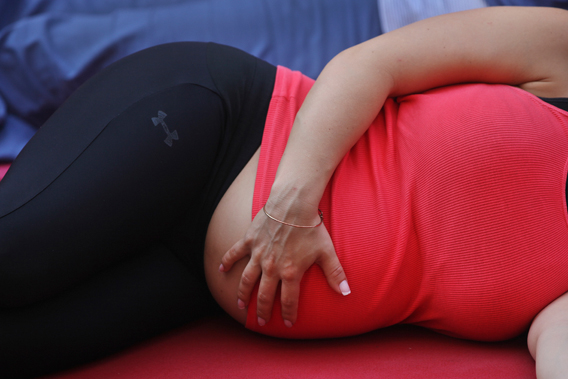The Pain Threshold
Banning abortions at 20 weeks is just the beginning of a plan to outlaw them altogether.

Photo by Shannon Stapleton/Reuters
You can also listen to William Saletan read this piece.
Yesterday the U.S. House of Representatives voted to outlaw abortion at 20 weeks post-fertilization. That’s two weeks earlier than the common measure of fetal viability, the line previously drawn by the Supreme Court. Why 20 weeks? Because, according to Republican lawmakers, that’s the point at which science shows that the fetus is sufficiently developed to experience pain.
Actually, the science is much more complicated. The neural circuitry that culminates in pain perception begins to form long before 20 weeks, and most researchers believe that the signals conveyed by this circuitry aren’t perceived as pain until the brain develops that perceptive capacity well after 20 weeks. The evidence is opaque and debatable. What’s clear is that 20 weeks is just a politically convenient line drawn, for the time being, along this continuum. If pro-lifers can nudge Congress, the public, and the Supreme Court from the viability marker to the pain marker, they’ll keep pushing the line backward until abortion is completely illegal.
Don’t take my word for it. Read their bill, their testimony, and their speeches in yesterday’s debate.
Rep. Marsha Blackburn, R-Tenn., managed the debate for pro-lifers. “We know that at eight weeks, babies feel pain,” she told her colleagues. Eight weeks? What happened to 20? The answer is that fetal pain is ambiguous. You can stretch the definition to justify banning abortions much earlier than 20 weeks. Maureen Condic, the pro-lifers’ go-to neuroscientist, laid out the timeline at a recent House subcommittee hearing. Here’s the text of her presentation slide (shown just before the 1:15 mark on the hearing video):
Milestones in pain development
4 weeks: Basic structures of nervous system established.
4 weeks: Earliest neurons in the cortex are born.
7 weeks: Synapse formation begins in cortex.
8-10 weeks: Spinal circuitry for pain detection is established. The fetus is capable of reacting to painful sensory input.
8-10 weeks: Subcortico-frontal pathways established.
12-18 weeks: Spino-thalamic pathways established. The fetus is capable of mature pain perception.
22-24 weeks: Long-range cortical projections form.
None of these milestones occurs at 20 weeks. The timeline is an invitation to shift the legal limit backward from 20 weeks to 18 to 12 to eight and eventually to four. Once you accept pain as the legal standard, the definition of pain can be broadened from actual pain perception to the spinal capacity for pain perception to the capacity to react to painful stimuli, even if the fetus doesn’t experience them as pain. “The neural circuitry underlying the most basic response to pain is in place by eight weeks,” Condic testified. “It is entirely uncontested in the scientific and medical literature that a fetus experiences pain in some capacity from as early as eight weeks.”
If you don’t buy these claims about pain, pro-lifers will tell you that early fetuses should nevertheless be legally protected, on the grounds that they’ve developed a sense of touch. The fetal pain bill incorporates this argument, asserting, “By 8 weeks after fertilization, the unborn child reacts to touch.” In yesterday’s debate, Rep. Martha Roby, R-Ala., urged her colleagues to protect “babies far along enough in development to feel touch, to respond to touch.” Blackburn agreed: “Scientific evidence tells us that unborn babies can feel touch as soon as eight weeks into the pregnancy.”
If you don’t accept the claims about tactile sensation, pro-lifers can cite other milestones. “After three weeks, the baby has a heartbeat,” said Rep. Ann Wagner, R-Mo. “After seven weeks, the baby begins kicking in the womb. By week eight, the baby begins to hear, and fingerprints start to form. After 10 weeks, the baby is able to turn his or her head, frown, and even hiccup. By week 11, the baby can grasp with his or her hands, and by week 12, the baby can suck his or her thumb.”
Fetal development moves forward along this continuum, but the pro-life political agenda moves backward. First you draw the line at viability. Then you draw it at pain capacity. Then you draw it at thumbsucking. Then you draw it at hearing. Then you draw it at kicking. Then you draw it at heartbeats. Pro-lifers aren’t sure where these lines fall. Michele Bachmann says the heartbeat begins eight weeks after conception. Rep. Eric Cantor, the House majority leader, says it starts at six weeks. Wagner says it starts at three. The lines are fuzzy because the baby’s systems form slowly, allowing you to backdate your interpretation to the earliest function that looks like a heartbeat, kick, or cringe.
Look around the country, and you’ll see what’s in store. Eight states have enacted bans like the one that passed the House, prohibiting abortions 22 weeks after the woman’s last menstrual period (LMP), i.e., 20 weeks after estimated fertilization. Arizona has banned abortions at 20 weeks LMP, based on the same pain theory. Arkansas has banned them at 12 weeks LMP, based on the detectability of heartbeats by ultrasound. North Dakota has banned them at six weeks LMP—four weeks after fertilization—based on the detectability of heartbeats by a transvaginal probe.
Ultimately, pro-lifers plan to outlaw abortions at conception. They believe, in Wagner’s words, that “killing an unborn child is unacceptable at any time.” But to get there, they need you to start small, by letting go of the viability standard and shifting to the pain standard. Then it’s all downhill. “If we find [killing] so horrendous one minute after birth, shouldn't it be horrendous one minute before birth?” asks Rep. Andy Harris, R-Md. “And if it's one minute before birth, how about one week? How about one month? How about two months? We can go all the way back.” And they will.
William Saletan's latest short takes on the news, via Twitter:
